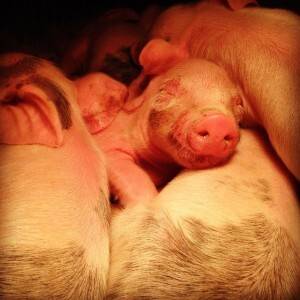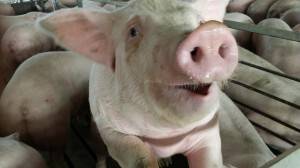It has been awhile since I’ve written about what I like to do every day… Take care of pigs! This week I have my first meeting to gather information about my next group of pigs. They will nurse on the sow (the female that gave birth to them) for three weeks, and then spend seven weeks in a nursery facility. When they are about 10 weeks old and weigh an average of 50 pounds, they will be transported to my finishing barns.
Each type of barn has been designed to meet the pigs’ needs at a particular age. In the farrowing barn, a farrowing crate keeps the piglets safe from being laid on or stepped on by the sow. This environment has proven to take the very best care of pigs because the farrowing barn is warm, clean and free of disease. It’s also safer and easier for workers to do their best work. 
The baby pigs are weaned at about 12-15 pounds and are moved into the nursery barn. Here they receive fresh water, fresh air, and the perfect feed ration to get them off to a good start.
The pigs grow from about 12 to 50 pounds in the nursery barn. When they’re about 10 weeks old, they’re transported to a finishing barn. This is where I come in! Pigs arrive on my farm in a semi that has been cleaned and disinfected, complete with bedding and ventilation to keep them comfortable inside. To make sure the pigs have the best trip possible, the semi driver has been certified in the Trucker Quality Assurance (TQA) program. This is similar to the Pork Quality Assurance Plus program under which I am certified.
I start planning for my next group of pigs before I’ve even finished with the pigs in my barn. As I mentioned, later this week I will have my first meeting about the next group of pigs I will receive. Next week I should have all of the current group finished and off to market. Then I’ll make needed repairs to the facility before cleaning and disinfecting it. Then it’s time to bring in the new pigs!
The last group of pigs I finished had a daily rate of gain of two pounds per day. Their feed efficiency, or the amount of grain they eat to gain weight, was 1 pound of gain for 2.35 pounds of feed. Usually feed efficiency decreases as the pigs grow larger. When pigs are giving you numbers like 2.35, you know things are working well!
 Today’s pigs gain more weight but eat less feed than in the past. In fact, my pigs use only ¼ of the crop land that was used when I started farming. We’re raising twice as much corn per acre as when I started farming, and the pigs use only half as much now to reach market weight. Talk about an efficiency increase!
Today’s pigs gain more weight but eat less feed than in the past. In fact, my pigs use only ¼ of the crop land that was used when I started farming. We’re raising twice as much corn per acre as when I started farming, and the pigs use only half as much now to reach market weight. Talk about an efficiency increase!
Farmers have definitely improved and strive to be better. We will take even better care of the pigs and our farm ground. That’s what farmers do – and this is sustainable agriculture.
To learn more about #RealPigFarming, follow along with me and these producers:
- Farm Girl with Curls – Lauren incorporates great photography and videos into her blog.
- Food and Swine – An award-winning baker and cook, Cristen shares her recipes as she tells how her family raises pork.
- Minnesota Farm Living – Wanda explains “the how and why” behind pork production on her family’s farm. She has a unique ability to explain complex issues like “Why we use individual gestation pens” and “What you really need to know about the use of antibiotics in livestock production.”
